


About

IN EVERY ISSUE
1.
PRESIDENT'S MESSAGE
From Intel to Impact: Why Insight Fuels Connection

2.
Publisher’s Message
Lighting the Path with Insight

3.
FROM THE EDITOR
Insight - Gather, Filter, and Inform

Calendar of Events
4.

FEATURES
5.
From Loyalty to Leadership: How Voice of the Customer Research Elevates Strategy

6.
Becoming a Market-Connected Marketer: The Importance of Being All-In

7.
A Minimalist's Approach to Knowledge Management

8.
The Cross-Industry Playbook for Better A/E/C Marketing

9.
Reading the Signals: Early Insights from a Changing A/E/C Landscape

How Voice of the Customer Research Elevates Strategy
In today’s dynamic A/E/C environment, customer loyalty is no longer enough to remain competitive. For firms committed to strategic growth, loyalty must be deepened into insight, and insight must translate into action.
Strategy is not a static plan but a competitive game plan activated through marketing, business development, and the systems and resources that support it. This belief reframes how we view client relationships. It’s not just about delivering projects on time or generating repeat work. True differentiation comes from understanding your clients better than anyone else and shaping strategy around that understanding.
Why Repeat Business Isn’t Always Loyalty
It’s easy to assume that repeat business signifies strong client loyalty. However, in the A/E/C industry, that assumption can be misleading. Clients may return simply out of convenience, lack of alternatives, or to fill capacity gaps, not because they view your firm as a strategic partner.
True loyalty stems from preference, not just presence. It’s when clients actively choose your firm because they believe in your value, trust your expertise, and see you as integral to their success. The only way to truly understand why clients come back and whether they’d choose you again, given more options, is to ask them.
That’s the value of structured Voice of the Customer research. It moves beyond assumptions and uncovers the underlying drivers of client decisions. Are you the firm they call first? Or just the available one? VoC reveals the difference and helps you strengthen relationships where it matters most.

True loyalty stems from preference, not just presence. It’s when clients actively choose your firm because they believe in your value, trust your expertise, and see you as integral to their success.
Voice of the Customer: Insight as a Strategic Asset
Voice of the Customer (VoC) research is a powerful tool for firms looking to sharpen their strategy and deepen client relationships. It goes beyond anecdotal feedback and project-specific evaluations to capture how clients truly experience your firm, what they value, what frustrates them, and where they see unmet needs.
By formalizing client feedback through interviews, surveys, or third-party studies, VoC reveals patterns that individual conversations often miss. It helps you understand which clients are true advocates, who are passively satisfied, and who might be at risk of leaving. That distinction is critical, especially in a market where reputation and relationships drive long-term success.
When used strategically, VoC becomes more than a listening exercise. It’s the foundation for more thoughtful, more focused decision-making. It informs where you compete, how you differentiate, and how you allocate resources across your marketing and business development efforts. It shifts strategy from inside-out assumptions to outside-in insight, where the market, not just internal goals, drives your direction.

Turning Insight into Strategy
VoC findings should feed directly into the strategic planning process. The foundation of an actionable strategy is the Five Cs of research: Climate, Customer, Competitors, Collaborators, and Company. VoC plays a pivotal role in the “Customer” pillar, shaping decisions about who to serve, how to engage, and where to allocate resources.
For example:
- If clients consistently highlight responsiveness over price, your competitive advantage may lie in service culture, not low bids.
- If certain clients only award you “C” projects, your brand perception needs attention, and your pursuit strategy might need recalibration.
- If multiple clients express uncertainty about your value post-project, that’s a signal to bolster your handoff processes and long-term engagement models.
Activating Insight Through Marketing and Business Development
Customer insight alone will not shift market position. To be actionable, it must be embedded in your marketing and business development systems.
Marketing uses VoC to refine positioning, tailor messaging, and build trust. Business development uses it to qualify leads, anticipate objections, and align solutions to client-specific needs. Together, they bring strategy to life at every client touchpoint, pursuit conversation, and project kickoff.
From Insight to Impact
Firms that treat client research as a one-off or check-the-box activity miss the point. Client insight is not a tactic; it’s a strategic asset. It’s how you evolve beyond reactive service and into proactive leadership. And leadership makes all the difference in a market defined by tightening margins, shifting expectations, and heightened competition.
Bottom line: Research makes strategy smart. If you want your firm to stand out, start by listening and then let those insights shape everything you do.
Julie Witecki, MBA, CPSM helps AEC firms turn strategy into action. With an extensive marketing and business development background for a national general contractor, Julie specializes in aligning go-to-market efforts with research-driven strategy. As a senior strategy consultant at FMI Consulting, she works with clients to define their competitive advantage and embed it across their marketing systems, business development processes, and client experiences. Her approach connects insight to execution, ensuring strategy isn’t just smart but measurable, focused, and built for results.

Connect on Linkedin










